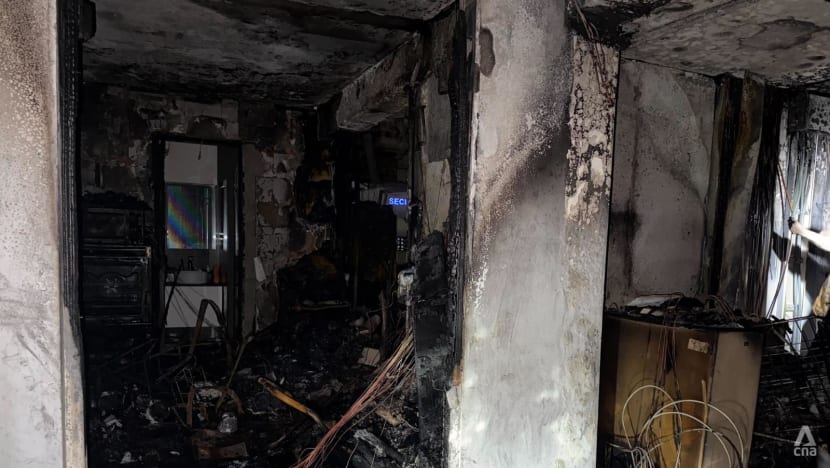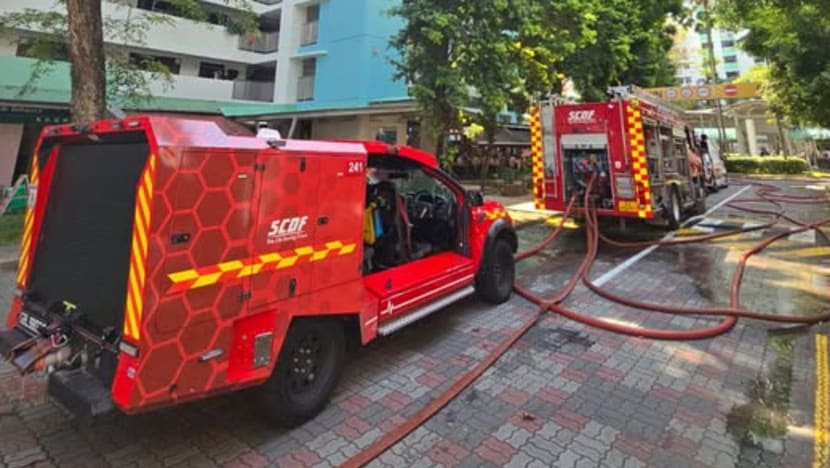Toa Payoh fire: Faulty dry riser could be due to underground pipe leak, says town council
PUB clarified that there were no leaks to its water pipes supplying water to the location, and that the underground pipe that was leaking is part of the housing block’s internal firefighting infrastructure.

The aftermath of a fire that razed a flat on the 10th floor of Block 229 Toa Payoh Lorong 8. (Photo: CNA/Charmaine Jacob)

This audio is generated by an AI tool.
SINGAPORE: The faulty dry riser at a Toa Payoh block could be due to an underground pipe leak, Bishan-Toa Payoh Town Council said on Thursday (Jul 31), adding that the system was found to be working during an inspection in August last year.
A fire broke out at Block 229 Lorong 8 Toa Payoh on Tuesday afternoon. It started in a flat on the 10th floor and spread to another unit on the 11th floor. Seven people were taken to hospital, including a child and a firefighter.
National water agency PUB released a statement on Thursday evening to clarify that the leak does not involve PUB's water pipes that supply water to the location.
"The underground pipe which was leaking is part of the housing block’s internal firefighting infrastructure," said PUB.
The Singapore Civil Defence Force (SCDF) said on Wednesday that during the firefighting operation, firefighters discovered that the block's dry rising main was not in "proper working condition", and water could not be "charged up" to the affected floors.
A dry rising main is a vertical red pipe installed in a building. During a fire, it will be charged with water from a fire engine to facilitate firefighting operations on higher floors.
Firefighters instead set up hoses directly from the fire engine at the ground level to establish a water supply to the 10th and 11th floors via the staircase.

Bishan-Toa Payoh Town Council said it was informed of the matter by SCDF after the fire was extinguished. Both SCDF and the town council then conducted a joint inspection of the dry riser.
SCDF requires a hydrostatic test of the dry riser to be conducted annually, said the town council.
"The specific dry riser at Block 229 was last tested by an authorised fire prevention and protection system contractor on Aug 28, 2024 and was found to be in working condition. The next inspection for the dry riser is scheduled on Aug 5, 2025," it added.
"In our discussion with SCDF, the probable reason for the failure of the dry riser could be due to an underground pipe leak. The annual hydrostatic test includes checks to detect such leaks."
FIRE IN 2020 "UNRELATED"
Bishan-Toa Payoh Town Council also said the fire suppression systems involved in Tuesday’s fire and a separate blaze at Block 138C Lorong 1A Toa Payoh in August 2020 were unrelated.
The incident in 2020 involved a wet riser system, while the current incident involves a dry riser system.
During the high-rise blaze at The Peak on Aug 29, 2020, emergency personnel discovered that the block’s wet riser was faulty.
The fire was later put out with hose reels with no loss of life. Three people were taken to hospital and another 300 were evacuated.
Following the incident in 2020, the town council said it engaged a professional engineer to conduct a thorough independent investigation.
The professional engineer determined that the wet riser showed no signs of failure or deterioration, and the probable cause was due to the unintentional closure of the riser isolation switch by the contractor during their routine inspection.
Subsequently, the SCDF conducted “comprehensive inspections” and concluded that all fire safety systems were in good working order.
"The wet riser system at Block 138C Lorong 1A Toa Payoh has been properly maintained and remains in full working condition," said Bishan-Toa Payoh Town Council.














